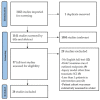Hypothermia Therapy for Traumatic Spinal Cord Injury: An Updated Review
- PMID: 35329911
- PMCID: PMC8949322
- DOI: 10.3390/jcm11061585
Hypothermia Therapy for Traumatic Spinal Cord Injury: An Updated Review
Abstract
Although hypothermia has shown to protect against ischemic and traumatic neuronal death, its potential role in neurologic recovery following traumatic spinal cord injury (TSCI) remains incompletely understood. Herein, we systematically review the safety and efficacy of hypothermia therapy for TSCI. The English medical literature was reviewed using PRISMA guidelines to identify preclinical and clinical studies examining the safety and efficacy of hypothermia following TSCI. Fifty-seven articles met full-text review criteria, of which twenty-eight were included. The main outcomes of interest were neurological recovery and postoperative complications. Among the 24 preclinical studies, both systemic and local hypothermia significantly improved neurologic recovery. In aggregate, the 4 clinical studies enrolled 60 patients for treatment, with 35 receiving systemic hypothermia and 25 local hypothermia. The most frequent complications were respiratory in nature. No patients suffered neurologic deterioration because of hypothermia treatment. Rates of American Spinal Injury Association (AIS) grade conversion after systemic hypothermia (35.5%) were higher when compared to multiple SCI database control studies (26.1%). However, no statistical conclusions could be drawn regarding the efficacy of hypothermia in humans. These limited clinical trials show promise and suggest therapeutic hypothermia to be safe in TSCI patients, though its effect on neurological recovery remains unclear. The preclinical literature supports the efficacy of hypothermia after TSCI. Further clinical trials are warranted to conclusively determine the effects of hypothermia on neurological recovery as well as the ideal means of administration necessary for achieving efficacy in TSCI.
Keywords: hypothermia; recovery; spine; trauma.
Conflict of interest statement
The authors declare no conflict of interest.
Figures
Similar articles
-
The use of classification and regression tree analysis to identify the optimal surgical timing for improving neurological outcomes following motor-complete thoracolumbar traumatic spinal cord injury.Spinal Cord. 2020 Jun;58(6):682-688. doi: 10.1038/s41393-020-0412-z. Epub 2020 Jan 28. Spinal Cord. 2020. PMID: 31992857
-
Safety and Clinical Efficacy of Mesenchymal Stem Cell Treatment in Traumatic Spinal Cord Injury, Multiple Sclerosis and Ischemic Stroke - A Systematic Review and Meta-Analysis.Front Neurol. 2022 May 30;13:891514. doi: 10.3389/fneur.2022.891514. eCollection 2022. Front Neurol. 2022. PMID: 35711260 Free PMC article.
-
Minimizing errors in acute traumatic spinal cord injury trials by acknowledging the heterogeneity of spinal cord anatomy and injury severity: an observational Canadian cohort analysis.J Neurotrauma. 2014 Sep 15;31(18):1540-7. doi: 10.1089/neu.2013.3278. Epub 2014 Jul 8. J Neurotrauma. 2014. PMID: 24811484 Free PMC article.
-
Pursuing More Aggressive Timelines in the Surgical Treatment of Traumatic Spinal Cord Injury (TSCI): A Retrospective Cohort Study with Subgroup Analysis.J Clin Med. 2021 Dec 20;10(24):5977. doi: 10.3390/jcm10245977. J Clin Med. 2021. PMID: 34945273 Free PMC article.
-
Outcome Prediction in Spinal Cord Injury: Myth or Reality.World Neurosurg. 2020 Aug;140:574-590. doi: 10.1016/j.wneu.2020.05.043. Epub 2020 May 11. World Neurosurg. 2020. PMID: 32437998 Review.
Cited by
-
Clinical Assessment and Management of Acute Spinal Cord Injury.J Clin Med. 2024 Sep 25;13(19):5719. doi: 10.3390/jcm13195719. J Clin Med. 2024. PMID: 39407779 Free PMC article. Review.
-
Critical Care of Spinal Cord Injury.Curr Neurol Neurosci Rep. 2024 Sep;24(9):355-363. doi: 10.1007/s11910-024-01357-8. Epub 2024 Jul 15. Curr Neurol Neurosci Rep. 2024. PMID: 39008022 Review.
-
Clinical Trials Targeting Secondary Damage after Traumatic Spinal Cord Injury.Int J Mol Sci. 2023 Feb 14;24(4):3824. doi: 10.3390/ijms24043824. Int J Mol Sci. 2023. PMID: 36835233 Free PMC article. Review.
-
Neuroprotective Role of THBS2 in Experimental Spinal Cord Injury Via its Anti-neuroinflammatory and Anti-apoptotic Properties.Biochem Genet. 2025 Jun 26. doi: 10.1007/s10528-025-11160-w. Online ahead of print. Biochem Genet. 2025. PMID: 40571842
-
Bridging the gap: a translational perspective in spinal cord injury.Exp Biol Med (Maywood). 2024 Sep 26;249:10266. doi: 10.3389/ebm.2024.10266. eCollection 2024. Exp Biol Med (Maywood). 2024. PMID: 39391076 Free PMC article. Review.
References
-
- National Spinal Cord Injury Statistical Center . Facts and Figures at a Glance. University of Alabama at Birmingham; Birmingham, AL, USA: 2020.
Publication types
LinkOut - more resources
Full Text Sources
Miscellaneous




